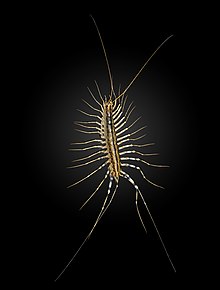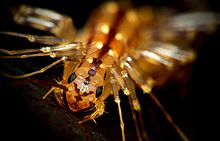
Centipedes are predatory arthropods belonging to the class Chilopoda of the subphylum Myriapoda, an arthropod group which includes millipedes and other multi-legged animals. Centipedes are elongated segmented (metameric) creatures with one pair of legs per body segment. All centipedes are venomous and can inflict painful stings, injecting their venom through pincer-like appendages known as forcipules or toxicognaths, which are actually modified legs instead of fangs. Despite the name, no centipede has exactly 100 pairs of legs; number of legs ranges from 15 pairs to 191 pairs, always an odd number.
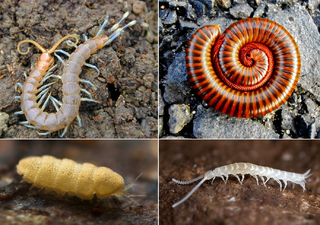
Myriapods are the members of subphylum Myriapoda, containing arthropods such as millipedes and centipedes. The group contains about 13,000 species, all of them terrestrial.

A stinger is a sharp organ found in various animals capable of injecting venom, usually by piercing the epidermis of another animal.

Scolopendra heros, commonly known as the Arizona desert centipede, giant desert centipede, giant Sonoran centipede, Texas black-tailed centipede, Texas redheaded centipede, and giant redheaded centipede, is a species of North American centipede found in the Southwestern United States and Northern Mexico.

Scutigera is a centipede genus in the scutigeromorph family Scutigeridae, a group of centipedes with long limbs and true compound eyes. It compose of more than 30 species, including the most common and well-studied Scutigera coleoptrata.

Scolopendra gigantea, also known as the Peruvian giant yellow-leg centipede or Amazonian giant centipede, is a centipede in the genus Scolopendra. It is the largest centipede species in the world, with a length exceeding 30 centimetres (12 in). Specimens may have 21 or 23 segments. It is found in various places throughout South America and the extreme south Caribbean, where it preys on a wide variety of animals, including other sizable arthropods, amphibians, mammals and reptiles.

The Chinese red-headed centipede, also known as the Chinese red head, is a centipede from East Asia. It averages 20 cm (8 in) in length and lives in damp environments.
The arthropod leg is a form of jointed appendage of arthropods, usually used for walking. Many of the terms used for arthropod leg segments are of Latin origin, and may be confused with terms for bones: coxa, trochanter, femur, tibia, tarsus, ischium, metatarsus, carpus, dactylus, patella.

The mouthparts of arthropods have evolved into a number of forms, each adapted to a different style or mode of feeding. Most mouthparts represent modified, paired appendages, which in ancestral forms would have appeared more like legs than mouthparts. In general, arthropods have mouthparts for cutting, chewing, piercing, sucking, shredding, siphoning, and filtering. This article outlines the basic elements of four arthropod groups: insects, myriapods, crustaceans and chelicerates. Insects are used as the model, with the novel mouthparts of the other groups introduced in turn. Insects are not, however, the ancestral form of the other arthropods discussed here.

Scolopendra subspinipes is a species of very large centipede found throughout southeastern Asia. One of the most widespread and common species in the genus Scolopendra, it is also found on virtually all land areas around and within the Indian Ocean, all of tropical and subtropical Asia from Russia to the islands of Malaysia and Indonesia, Australia, South and Central America, the Caribbean islands, and possibly parts of the southern United States, but how much of this range is natural and how much due to human introduction is unclear. With a wide geographic range and numerous color variations, the species is known by many common names, including jungle centipede, orange-legged centipede, Hawaiian centipede, and Vietnamese centipede.
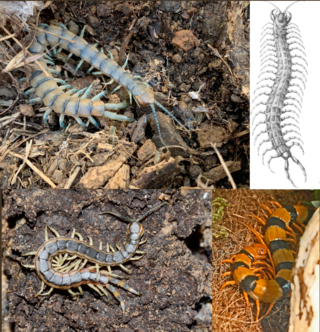
Scolopendra is a species-rich genus of large tropical centipedes of the family Scolopendridae.

The Scolopendromorpha, also known as tropical centipedes and bark centipedes, are an order of centipedes whose members are epimorphic and usually possess 21 or 23 trunk segments with the same number of paired legs. The number of leg pairs is fixed at 21 for most species in this order and fixed at 23 for the remaining species, except for two species with intraspecific variation: Scolopendropsis bahiensis, which has 21 or 23 leg pairs, and Scolopendropsis duplicata, which has 39 or 43 leg pairs. Species in this order have antennae with 17 or more segments. The order comprises the five families Cryptopidae, Scolopendridae, Mimopidae, Scolopocryptopidae, and Plutoniumidae. Nearly all species in the family Scolopendridae have four ocelli on each side of the head, and the genus Mimops features a pale area often considered an ocellus on each side of the head, whereas the other three families are blind. Species in the family Scolopocryptopidae have 23 leg-bearing segments, whereas species in all other families in this order have only 21 leg-bearing segments. The only 3 known amphibious centipedes, Scolopendra cataracta, Scolopendra paradoxa and Scolopendra alcyona belong to this order.
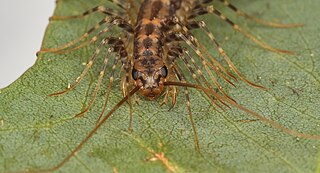
Scutigeromorpha is an order of centipedes also known as house centipedes. These centipedes are found in the temperate and tropical parts of every continent except Antarctica, with their distribution significantly expanded by the introduction of the Mediterranean species Scutigera coleoptrata throughout Europe, Asia, and North America. The common species S. coleoptrata is a typical representative of this order, lying in wait for other arthropods, then seizing prey using great speed, and all species in this order reflect adaptations for this mode of life.

Allothereua maculata is a species of centipedes found in Australia known as the house centipede – a name applied elsewhere to other species.
In the 10th edition of Systema Naturae of 1758–1759, Carl Linnaeus classified the arthropods, including insects, arachnids and crustaceans, among his class "Insecta". He described the Insecta as:
A very numerous and various class consisting of small animals, breathing through lateral spiracles, armed on all sides with a bony skin, or covered with hair; furnished with many feet, and moveable antennae, which project from the head, and are the probable instruments of sensation.

Scolopendra morsitans, also known as the Tanzanian blue ringleg or red-headed centipede, is a species of centipede in the family Scolopendridae. S. morsitans is the type species for the genus Scolopendra.

Scolopendra dehaani, common name Giant Vietnamese centipede, is a large Scolopendrid centipede found across Mainland Southeast Asia. It is also found in India, Japan, Hong Kong, and the Andaman and Nicobar Islands.
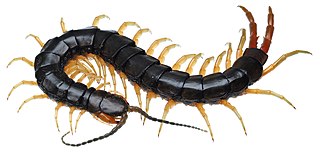
Scolopendra japonica, formerly classified as Scolopendra subspinipes japonica, is a species of scolopendrid centipede mostly found in Japan, although specimens have been reported in other parts of Eastern Asia such as China, Taiwan, Myanmar, Cambodia, and Laos. They usually grow between 7.5 and 13 centimetres in length. It is known by the common names Japanese giant centipede and blue-head centipede.

Scolopendra dawydoffi is a species of large Scolopendrid centipede found in Southeast Asia, specifically in Laos, Vietnam, Thailand, and Malaysia. It has bright reddish-orange and black colouration, and can grow up to and beyond 16 cm in length.
